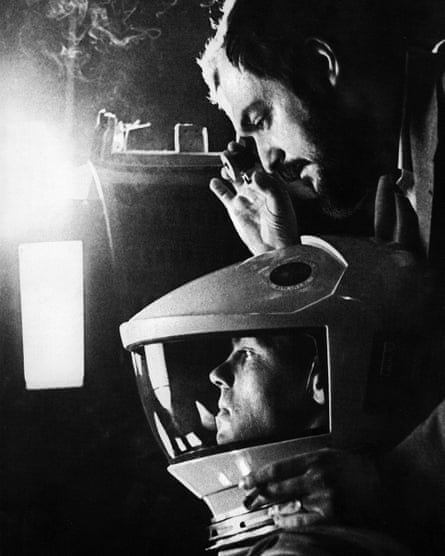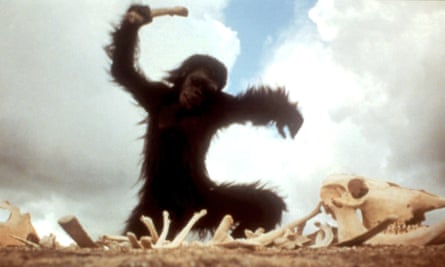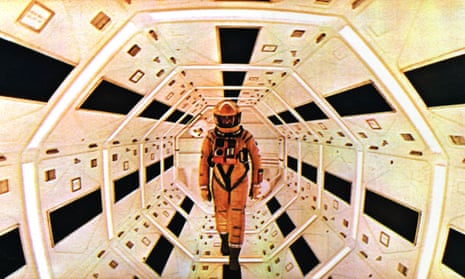Astronomers last week announced official names for the principal mountains and valleys of one of the solar system’s remotest objects, the tiny world of Charon. More than 3.6bn miles distant from the Sun, the moon – which orbits the dwarf planet, Pluto – was first observed closely in 2015 when the US probe New Horizons swept over its freezing, airless surface.
Now the features revealed by the robot craft have been given titles by the International Astronomical Union. And key among the explorers and scientists honoured are the film director Stanley Kubrick and the writer Arthur C Clarke.
As a result Kubrick Mons and Clarke Montes are now two of Charon’s major mountains. It is a fitting honour – and timely. The two men’s great collaborative work, the film 2001: A Space Odyssey, was released 50 years ago this month. By putting its creators’ names on the map of Charon, at the edge of the solar system, astronomers are repaying a debt to two visionaries who reshaped our thinking about the cosmos and created a film rated by some as the greatest ever made.
Other celebrations of the film’s release include a recreation of the set of the film’s strange bedroom finale, which has just opened at Washington DC’s Air and Space Museum. In addition, the film-maker and writer Michael Benson’s book Space Odyssey: Stanley Kubrick, Arthur C Clarke, and the Making of a Masterpiece, is published this week. Benson describes the movie “as an art film made with a Hollywood blockbuster budget that is more comparable to a musical composition than to the usual dialogue-based commercial cinema”.
At the time, Kubrick had intended merely to make a science-fiction film that seemed credible. Clunky scripts, cardboard sets and crude cinematography marred most such films. So Kubrick turned to the British writer Clarke and the two worked on a script that slowly swelled in scope and ambition. Eventually they produced a story that covered the origins and destiny of the human species – a journey from ape to angel, as Kubrick put it.

According to their story, simple cavemen would encounter intelligent aliens who would help them acquire brainpower and so set humanity on the path to the planets. Once space travel had been achieved, humanity would make further contact with these aliens, who would then help us – after we had survived the murderous attentions of a supercomputer – to turn ourselves into a species with superhuman powers.
And this is what Kubrick eventually produced, although significant scenes were altered and dialogue written and rewritten throughout filming at MGM’s British studios in Borehamwood, Hertfordshire. Massive sets were constructed and props built and rejected. (The giant monoliths that appear in the film were clear Perspex initially, but were junked for the jet-black variety.)
The end result is striking. No words are spoken during the film’s first 25 minutes, and of its total 142 minutes’ running time only 40 contain speech. Its finale is enigmatic to the point of inscrutability. Audiences were baffled and more than 200 people, about a sixth of the audience, walked out before the end of the film’s premiere, says Benson. MGM was convinced it had backed “an epic disaster”. Even Clarke was disappointed by the film’s lack of concession to audience understanding, he later recalled.
Leading US film critics lined up to rubbish the movie: “trash masquerading as art,” claimed Pauline Kael in Harper’s. Fortunately for MGM, Kubrick and Clarke, this critical misfire was shortlived. The counterculture 1960s were then in full swing and young filmgoers were attracted by word of mouth (and ultimately the film poster’s tag line) suggesting that this was the “ultimate trip” movie. John Lennon even claimed at the time that he was going to see 2001 every week, while David Bowie produced his own musical tribute, Space Oddity, within a year. “Something was happening and older audiences did not necessarily know what it was,” says Benson.
Equally intrigued were young scientists desperate to witness technology that was credible and imaginative, something that had been entirely absent from feature films until then. “The film set new standards for ‘realistic’ portrayal of life in space, overcoming decades of Flash Gordon space-westerns,” says a former teenage astronomer, Professor Ian Christie of Birkbeck, University of London. “It also created a new soundtrack for cosmic spectacle – through the use of the opening of Strauss’s Also Sprach Zarathustra and the music of Ligeti.”
Similarly, astronomer Carl Murray, of Queen Mary, University of London, says the film was the first one that made him really think. He later became a member of the imaging team for the Cassini probe sent to Saturn in 2007. “We didn’t see any monoliths, but we all knew we owed a lot to Arthur C Clarke and Stanley Kubrick for inspiring our imaginations.”
In the end, 2001: A Space Odyssey became the highest-grossing film of 1968 – the only Kubrick picture ever to achieve such a standing. It also won Kubrick his only Oscar: for best visual effects (although they were actually the work of Douglas Trumbull).
The film also stimulated a generation of young cinema enthusiasts who have since dominated film-making. James Cameron, George Lucas, Ridley Scott, Steven Spielberg and Christopher Nolan have all acknowledged 2001 as a key influence on their output. “Stanley Kubrick made the ultimate science-fiction movie. It is going to be very hard for someone to come along and make a better movie, as far as I’m concerned,” says Lucas, creator of the Star Wars franchise.

This view is maintained by the current generation of younger directors, such as Gareth Edwards, director of Rogue One, one of the more recent Star Wars films. “It is a movie blockbuster while also being as artistic and abstract as you can get. No one would bankroll a film like this again. It is a phenomenon of its time,” Edwards told the Observer.
The film is not without its flaws, of course. In the early “Dawn of Man” sequences, Moonwatcher the apeman is inspired – by an alien monolith – to pick up a bone to use as a weapon, thus triggering an intellectual evolution that ends 4 million years later in modern humans and their propensity for war. The idea that violence underpins the human intellect is based on the ideas of anthropologist Raymond Dart, which were popularised in the 1960s by the writer Richard Ardrey, but which have since been discredited.
“They don’t reflect current thinking,” says palaeontologist Chris Stringer of the Natural History Museum in London. “Bones may have been used as tools, but for digging for roots and insects – not as clubs. That said, 2001 is still one of my favourite films – dazzling and mystifying in equal measure.”
There is another intriguing aspect about the timing of the film’s release. In 1968 humanity then seemed set for the stars. Only a few months after the film’s release, Apollo astronauts had reached the Moon and with a year had landed on it. The rest of the solar system would soon be conquered, it seemed. Space flight would become common. The film’s eponymous dateline therefore seemed prescient. However, the Vietnam war and other budgetary constraints ended that dream, though Clarke, who died in 2008, always remained optimistic about the prospects of further exploration.
In an interview at the end of the last century, he was asked what went wrong with his prediction. “Nothing very much, “ he replied. “America and Russia didn’t bother building more powerful, reusable launchers – they had other things on their minds – and that has made space too expensive for widespread use. Someone soon is going to get round that problem, however, and when that happens all the space stations and moonbases we envisaged will come about. I am very confident of that.”










Comments (…)
Sign in or create your Guardian account to join the discussion